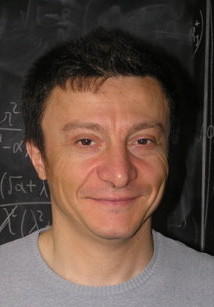 |
Olindo CORRADINI
Professore Associato
Dipartimento di Scienze Fisiche, Informatiche e Matematiche sede ex-Fisica
|
Insegnamento: Advanced Quantum Field Theory
Physics - Fisica (Offerta formativa 2024)
Obiettivi formativi
Knowledge and understanding :
This is a follow up course on Quantum Field Theory (QFT). In the first course we aimed to give students the main tools of the discipline and applied them to some introductory topics such as scalar field theory and spinor field theory. In the present course instead we are going to study more advanced materials such as the quantization of theories based on local (gauge) symmetry, i.e. gauge theories. These theories are indeed the main ingredients of the Standard Model of particle physics that describes with amazing precision the interactions of elementary particles.
Applying knowledge and understanding
At the end of the course the student will develop the skills to apply the knowledges acquired to an arbitrary QFT.
Making judgement
At the end of the course students should be able to choose by themselves the suitable mathematical approach to face the various problems arisen during the lessons.
Communications skills:
At the end of the course students should be able to describe with the appropriate technical language and the correct mathematical formalism the subject presented in the course.
Learning skills
At the end of the course students should have developed the skill to deepen by themselves the various general approached treated during the lessons and extend them to arbitrary QFT’s.
Prerequisiti
Knowledge of introductory topics of quantum field theory is strongly suggested. Specifically, introductory knowledge of functional methods in scalar field theories and spinor field theories, and their application to the perturbative computation of scattering processes is suggested. The necessary level is the one provided by a first-year Master Degree course of QFT.
Programma del corso
1) Introduction
Review of scalar, spinor QFT and abelian gauge theory: terminology, formalism, conventions, goals and main tools, Feynman rules and scattering amplitudes, LSZ reduction formulas. The Noether's theorem in QFT. Ward identities in spinor Quantum Electrodynamics and their consequences. 1 CFU
2) Nonabelian quantum field theory.
Hints of representation theory for non abelian groups. Nonabelian gauge field theory: generalities, nonabelian global and local symmetries, covariant derivatives, field strengths, Yang Mills lagrangian, representations. Path integrals, gauge-fixing, Fadeev-Popov trick. Feynman rules in pure Yang Mills theory, and spinor and scalar Quantum Chromo-Dynamics (QCD). Tree level and one-loop amplitudes in QCD. One loop divergences in spinor QCD and one loop beta functions. BRST quantization for a relativistic particle and for (pure) Yang Mills and its physical interpretation. BRST Ward identities and Slavon-Taylor operator in Yang Mills theory. Chiral theories, and problem of masses, spontaneous symmetry breaking of global and gauge symmetries. 2 CFU
3) Hints of Standard Model Physics.
Particle content, global and gauge symmetries, spontaneous symmetry breaking and Higgs sector. Leptonic and quark sectors. Flavor problem and CKM matrix. 2 CFU
4) Advanced topics. BRST symmetry. Supersymmetry. Massless particle and spinor helicity formalism. 1CFU
Metodi didattici
Blackboard lectures in presence, in English. Recorded materials will be provided. Attendance is not compulsory.
Office hours: Wednesday 15.00-17.00 or by appointment.
Testi di riferimento
M. Srednicki, Quantum Field Theory, Cambridge University Press 2007.
L. H. Ryder, Quantum Field Theory, Cambridge University Press 1996.
G. Sterman, An Introduction to Quantum Field Theory, Cambridge University Press 1993.
M. E. Peskin, D. V. Schroeder, An Introduction to Quantum Field Theory, Perseus Book Publishing 1995.
Verifica dell'apprendimento
Informal homework assignments will be provided each class. A final take-home exam, based on the assignments will be given, to test the problem solving skills. The resolution will be discussed during the oral exam and is worth an eventual 'cum laude'. The final oral exam last approx an hour, where four questions (a free choice one) will be asked to students. The examination could be split into two parts in case of students with a certified SLD. The final evalutation scheme is as follows:
18 points: basic knowledge and exposure skills
22 points: discrete knowledge and exposure skills
26 points: good knowledge and exposure skills
30 points: excellent knowledge and exposure skills
30 points cum laude: excellent knowledge and flowless exposure skills
Risultati attesi
Knowledge and understanding:
At the end of the course, students will have acquired all the necessary (standard) tools of quantum field theory (QFT).
Applying knowledge and understanding:
The knowledge will enable them to perform the computations of the arbitrary scattering processes, involving scalar particles, spinor particles and vector particles.
Making judgments:
Thanks to the variety of examples provided at the end of the course students will be able to recognize autonomously descriptive approaches and calculation methods appropriate to different types of problems of QFT.
Communicating skills:
Class discussions with teachers and peers will allow students to properly discuss standard arguments of quantum field theory, and some advanced ones.
Learning skills:
The knowledge acquired will allow them to independently study and learn other advanced topics of QFT and related subjects.